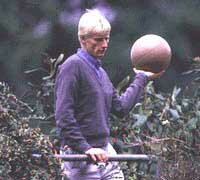
Environmental Enrichment
|
|
The Oregon Zoo has been a pioneer in providing a more meaningful life for captive animals through a behavioral and environmental enrichment program.In effect, enrichment activities encourage animals natural behavior and makes their life at the Zoo more interesting and more fun. The idea is to recreate in their zoo lives the same behavioral opportunities they would find in the wild.
An animal in the wild basically does only a few things," said Dr. David Shepherdson who coordinates the Zoo's enrichment program. "It hunts, eats, sleeps, often plays and breeds. But when they don't have to hunt for food or engage in normal activities like playing or exploring, they can quickly become bored, even morose."
An Example--Chimpanzee Termite Mounds
In the wild, chimps often come across large termite mounds in their native Africa. The bright chimps quickly find small sticks which they push down into the mound. Termites gather on the sticks and then the chimps pull them up, happily licking them off the stick as if it were a tasty ice cream cone.
Chimps at the Zoo are furnished with artificial termite mounds. Instead of actual termites, the chimps plunge their sticks into gobs of treats such as mustard, pie fillings, ketchup, apple sauce and other goodies they love.
They are doing what they do in the wild, only the taste results are different," Shepherdson said.
Other Zoo Enrichment Programs
Keepers try to stimulate animals' intellects, making them want to constantly explore their cages for potential food and fun with:
- Smells, such as spices and animal scents, are placed on logs or rocks in exhibits.
- Large, tough polyethylene balls go into the cage of our tiger. He likes to bang them around or pounce on them as if they were prey.
- Our tiger, Czar, hunts for fish and dry meat that keepers hide in logs, giving him a chance to smell and forage for his food as he would in the wild. Bears also get the "log" treatment, hunting in them for honey, raisins and nuts.
